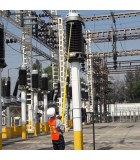TECHNIKELEC® markets the POSITRON high voltage insulator testers. Based on the unique technology of electric field measurement, POSITRON testers are currently the only know testers capable of diagnosing in real time the integrity and the state of ageing of your composite or silicone insulators, in addition to the traditional glass or procelain insulators.
POSITRON insulator testers are available in 3 models :
- high voltage line insulator tester glass and porcelain,
- high voltage line insulator tester composite or silicone,
- versatile multiform insulator tester for substations and HV substations, in glass, porcelain and silicone.
Thus, before any work is carried out on a substation in the vicinity of live insulators, you have a preliminary diagnostic tool enabling you to identify insulators with faults and at risk of failure.



